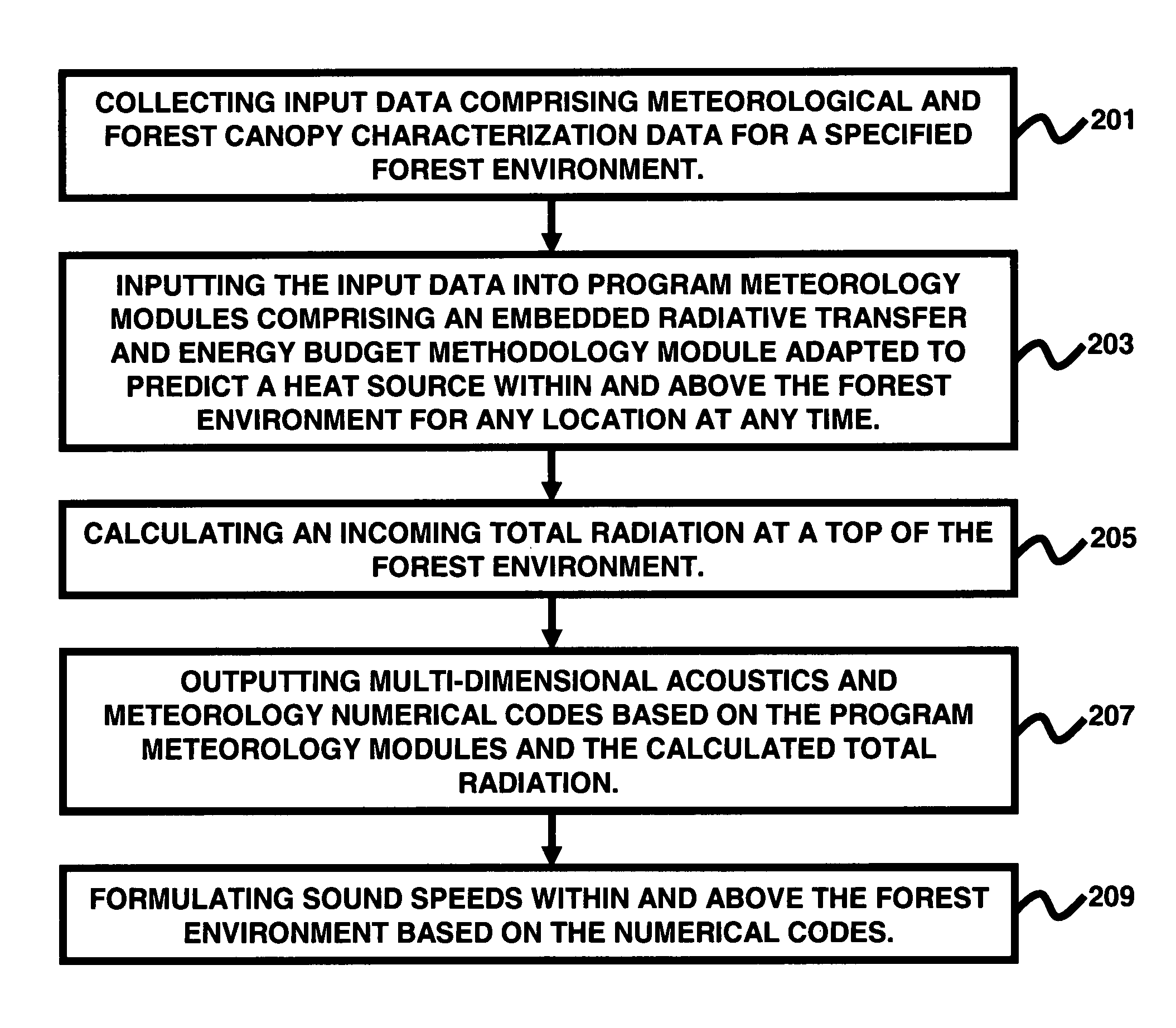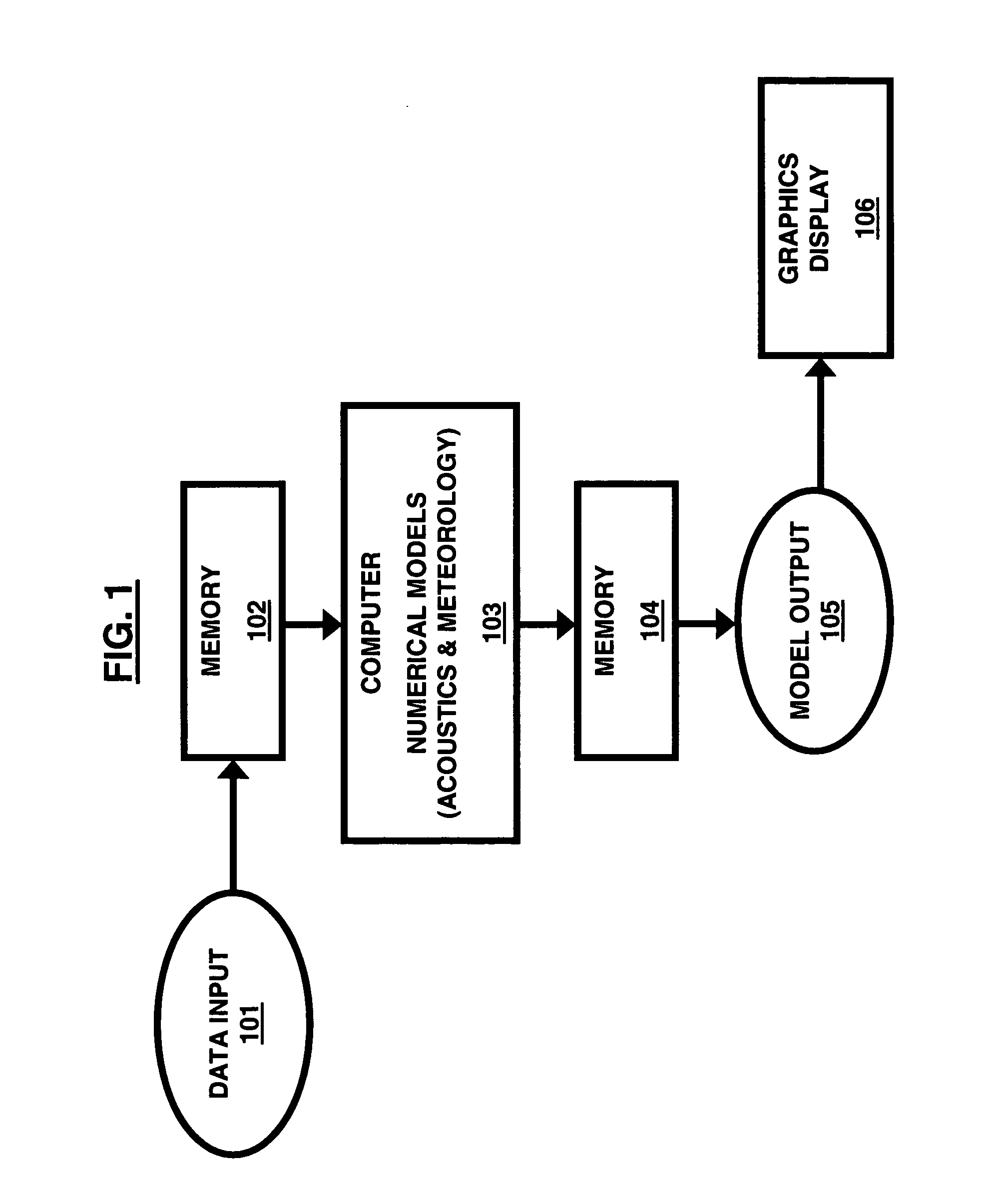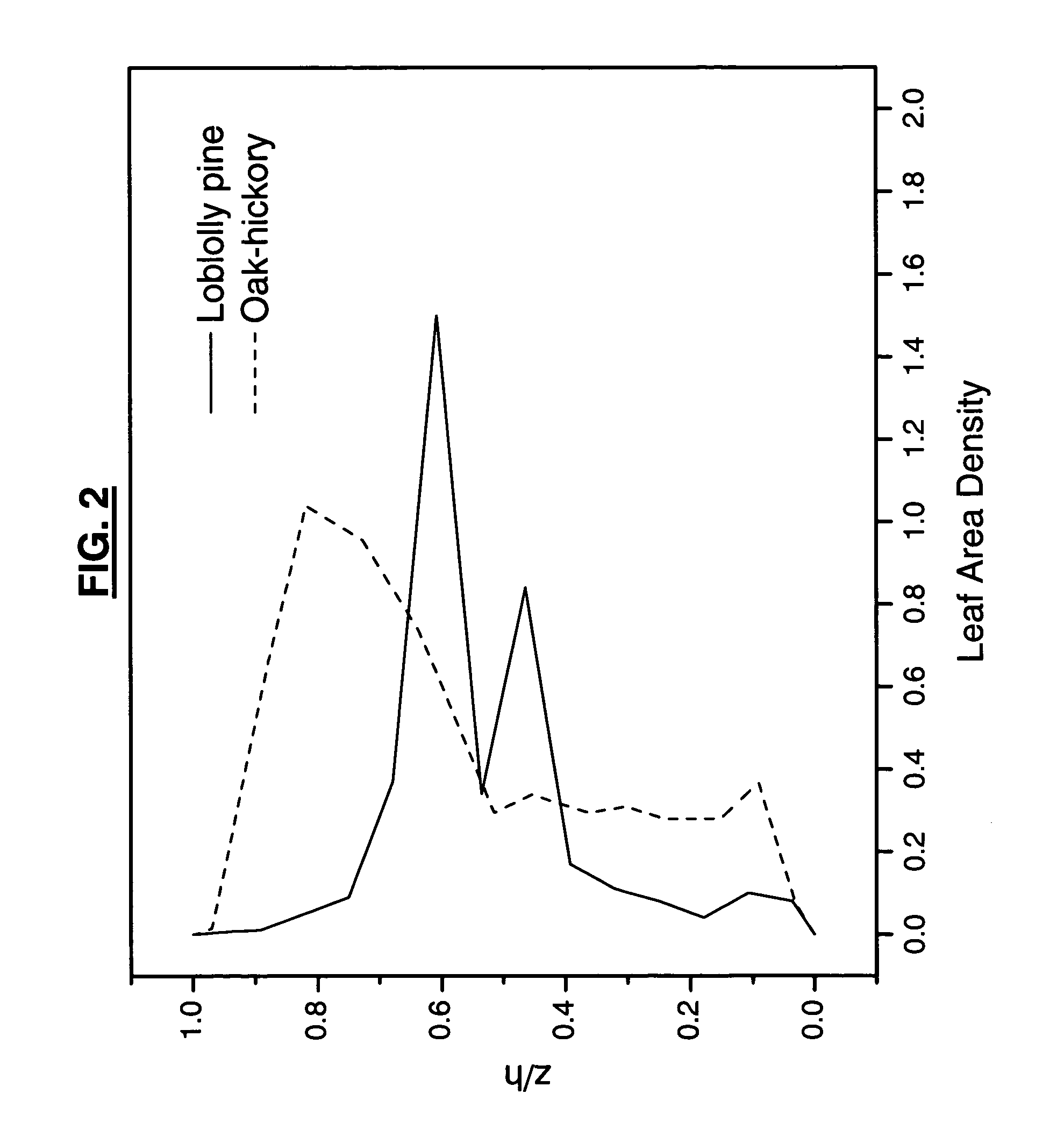[0011]Prior art related to
ray path model codes for
acoustic propagation and
transmission loss generally assume homogeneous sound and
wind speed fields (e.g., Moler CB and Solomon LP, “Use of splines and numerical integration in geometrical
acoustics.” J Acoust Soc Am 48: 739-744, 1970; Hallberg B, Larsson C and Israelsson S “Numerical
ray tracing in the atmospheric
surface layer” J Acoust Soc Am 83: 2059-2068, 1988; Huisman W H T “
Sound propagation over
vegetation-covered ground,” Dissertation, Univ. Nijmegen, The Netherlands, 176 pp., ISBN 90-9003624-5 (1990), Huisman W H T and Attenborough K “
Reverberation and attenuation in a
pine forest,” J Acoust Soc Am 90: 2664-2677 (1991), and Salomons E M “Computational atmospheric
acoustics,” Kluwer Academic Publishers, Dordrecht, 335 pp 2001). The
advantage of the invention described herein is that the acoustic models are based on the principles and theory for geometrical acoustics for an inhomogeneous moving medium.
Ray paths are thus computed as a function of range dependent wind and sound speed fields. These data are provided independently from 1D and 2D,
physics-based, meteorological model for forests (Tunick A (2003a) “Calculating the micrometeorological influences on the
speed of sound through the
atmosphere in forests,” J Acoust Soc Am 114: 1796-1806, Tunick, A. (2003b) A two-dimensional meteorological computer model for the forest
canopy. ARL-MR-569, US Army Research Laboratory, 2800
Powder Mill Rd, Adelphi, Md. 20783-1197, (2003), Tunick, A. (2004a): Toward improving the efficiency and realism of coupled meteorological-acoustic computer models for the forest canopy. ARL-MR-586, April, U.S. Army Research Laboratory, 2004). In addition, acoustic intensity due to geometrical
divergence (i.e.,
energy loss due to spherical spreading) is computed as an inverse function of range and the
height difference between two adjacent rays. At the same time, acoustic intensity
gain (or loss) due to frequency-dependent ground effects are included in the model calculation. Note that while the acoustic
numerical models embedded in this invention are much simpler than parabolic equation or fast field acoustic programs (West et al., 1991, 1992; Noble J M (2003) User's manual for the Microsoft window edition of the scanning fast-field program (SCAFFIP) version 3.0. ARL-TR-2696, US Army Research Laboratory, 2800
Powder Mill Rd, Adelphi, Md. 20783-1197. [Available from the DTIC at http: / / stinet.dtic.mil / str / ]),
ray path models have nevertheless been shown to be a practical and useful tool for analyzing and interpreting
refraction effects on sound
waves.
[0012]Other conventional models include first-order closure,
physics-based models, which are formulated to predict two-dimensional (2D) wind speeds and turbulence within and above forest canopies. Here,
radiation and energy budget methodologies are generally not included to predict the heat source (temperatures and sound speed). Additionally, second-order closure,
physics-based models have been developed to predict one-dimensional (1D) wind speeds and turbulence within and above forest canopies. Again, radiation and energy budget methodologies are not included to predict the heat source (temperatures and sound speed). Furthermore, higher-order closure, physics-based models such as three-dimensional (3D) Large Eddy
Simulation (LES) models have been formulated to predict 3D wind speeds, temperatures,
humidity, and turbulence within and above forest canopies. Here, radiation and energy budget algorithms are sometimes incorporated to predict the heat and
moisture sources. However, these models tend to be quite computationally intensive, especially with regard to turbulence and
advection scheme methodologies. Also, they can offer much more information related to soil and
plant physics than is necessary for the rapid and reliable prediction of sound speed in and around forest canopies.
[0013]Conventional techniques related to ray path model codes for
acoustic propagation and
transmission loss generally assume homogeneous sound and
wind speed fields. However, forest stands are typically inhomogeneous, containing non-uniform distributions of canopy height and leaf
area density. In addition, open fields, roadways, and buildings often border forests. Generally, the conventional techniques primarily show the development of forest canopy
wind flow and turbulence models only. However, there remains a need for a forest meteorology and acoustic computation technique that takes into account horizontally non-uniform sound speed information.
[0014]Furthermore, an
advantage of this invention over the prior art is that it combines the inventors' existing
numerical models developed in accordance with the invention and those still in development into a comprehensive process, which includes input, memory and computing devices, numerical codes, and
graphics display. The invention necessarily addresses both the thermodynamic and mechanical influences on sound speed within and above forest canopies.
Numerical models are executed in a computationally efficient framework. Hence, the invention is a novel process to obtain rapid and reliable predictions of useful acoustic and meteorological information, which can be applied to the study of meteorological aspects of acoustic propagation within and above forests.SUMMARY
[0015]In view of the foregoing, the embodiments herein provide a method of predicting multi-dimensional meteorological and acoustic effects within and above a forest environment, and a program storage device readable by computer, tangibly embodying a program of instructions
executable by the computer to perform a method of predicting multi-dimensional meteorological and acoustic effects within and above a forest environment, wherein the method comprises collecting input data comprising meteorological and forest canopy characterization data for a specified forest environment; inputting the input data into program meteorology modules comprising an embedded
radiative transfer and energy budget methodology module adapted to predict a heat source within and above the forest environment for any location at any time; calculating an incoming total radiation at a top of the forest environment; outputting multi-dimensional acoustics and meteorology numerical codes based on the program meteorology modules and the calculated total radiation; and formulating sound speeds within and above the forest environment based on the numerical codes. Preferably, the input data further comprises
site location data,
cloud cover data,
wind speed data, temperature data,
humidity data,
time of day data, day of year characteristics data, and environment characterization data for the forest environment.
[0016]Additionally, the environment characterization data preferably comprises tree height data, leaf
area density data, and
drag coefficient data affecting the forest environment. Moreover, the embedded
radiative transfer and energy budget methodology preferably predicts a heat source within and above the forest environment. Preferably, the calculating of the incoming total radiation at the top of the forest environment allows for calculations of a transmission, reflection, absorption, and emission of a solar flux within the forest environment. Also, the program meteorology modules may comprise
acoustic transmission loss modules, acoustic ray path modules, one-dimensional meteorological modules for the forest environments, and two-dimensional meteorological modules for forest environments. Preferably, the two-dimensional meteorological modules for the forest environments comprises variable grid modules, and wherein the method further comprises applying the variable grid modules to the
acoustic transmission loss modules and the acoustic ray path modules.
 Login to View More
Login to View More  Login to View More
Login to View More 


